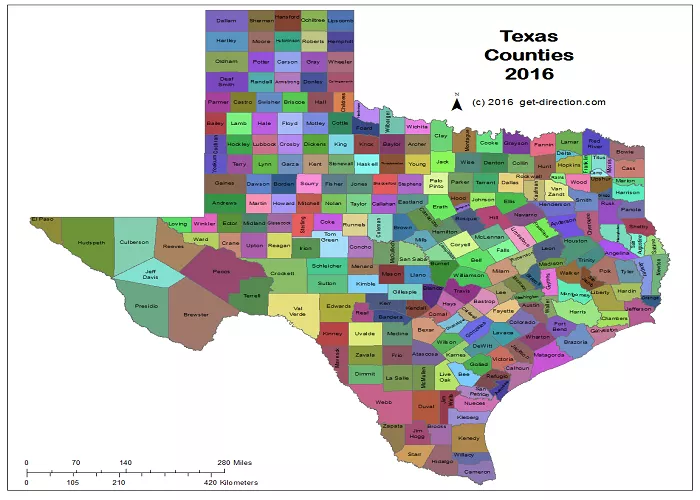Texas is a vast and diverse state, both in its geography and its administrative divisions. One of the most notable aspects of Texas’s administrative structure is its large number of counties. In fact, Texas has more counties than any other state in the United States. This article explores the number of counties in Texas and examines various aspects such as geographical location, culture, economy, and ecology.
Number of Counties in Texas
Texas is divided into 254 counties, the highest number of counties of any state in the U.S. These counties vary widely in size, population, and economic activity. For example, Loving County is the least populous, with just under 100 residents, while Harris County is the most populous, with over 4.6 million residents.
Historical Background
The concept of counties in Texas dates back to the period when the area was under Spanish and Mexican rule. During that time, the region was divided into municipalities. When Texas became an independent republic in 1836, these municipalities were converted into counties. Over time, as the population grew and settlements expanded, more counties were created to better manage local governance. The last county to be created was Kenedy County in 1921.
Geographical Distribution
Texas’s 254 counties are spread across a vast and varied landscape. The state’s geography includes coastal plains, rolling hills, deserts, and forests. This diversity influences the distribution and characteristics of the counties.
East Texas
East Texas is known for its dense forests, often referred to as the Piney Woods. This region receives more rainfall than other parts of the state, contributing to its lush vegetation. Counties in this area, such as Smith and Gregg, have economies historically rooted in agriculture and oil.
Central Texas
Central Texas includes the Texas Hill Country, characterized by rolling hills and clear rivers. Counties like Travis and Comal are located here. This region has seen significant growth due to its natural beauty and proximity to major cities like Austin and San Antonio.
West Texas
West Texas is more arid and includes desert landscapes. Counties here, such as El Paso and Brewster, are larger in area but often have lower population densities. The economy in this region is heavily influenced by oil and gas production.
Geographic Differences Among Texas Counties
Texas is so large that its counties vary dramatically in landscape.
Major Geographic Regions & Their Counties
| Region | Key Features | Example Counties |
|---|---|---|
| East Texas | Pine forests, bayous | Jefferson (Beaumont), Nacogdoches |
| Gulf Coast | Beaches, wetlands | Harris (Houston), Galveston |
| Hill Country | Rolling hills, rivers | Travis (Austin), Gillespie (Fredericksburg) |
| West Texas | Deserts, mountains | Brewster (Big Bend), El Paso |
| Panhandle | Plains, canyons | Potter (Amarillo), Randall (Canyon) |
Biggest vs. Smallest Counties
- Largest: Brewster County (6,192 sq. miles—bigger than Connecticut!)
- Smallest: Rockwall County (149 sq. miles)
Cultural Aspects
The cultural landscape of Texas counties is as diverse as its geography. Many counties reflect the heritage of the settlers who established them.
- Spanish Influence: Several counties have names of Spanish origin, reflecting the early exploration and settlement by Spanish explorers.
- German and Czech Settlements: Central Texas, particularly the Hill Country, saw significant German and Czech immigration. Counties like Comal and Fayette showcase this heritage through festivals, architecture, and cuisine.
- African American History: East Texas counties have rich African American histories, with communities that have contributed significantly to the state’s culture and civil rights movements.
Economic Overview
The economies of Texas counties vary based on their geographic location and natural resources.
- Agriculture: Counties like Hidalgo in the south are major producers of fruits and vegetables, benefiting from fertile soil and irrigation.
- Energy: West Texas counties are central to the state’s oil and gas industry, with numerous drilling operations and refineries.
- Technology and Services: Urban counties such as Travis (Austin) and Dallas have diversified economies with strong technology sectors and service industries.
Ecological Diversity
Texas’s vast size and varied climate zones contribute to its ecological diversity. Each county plays a role in preserving the state’s natural habitats.
- Forests: Eastern counties are home to dense pine forests, supporting timber industries and biodiversity.
- Deserts: Western counties encompass desert ecosystems, with unique flora and fauna adapted to arid conditions.
- Coastal Areas: Southern counties along the Gulf of Mexico have coastal wetlands and are crucial for fisheries and hurricane protection.
Conclusion
Texas’s 254 counties reflect the state’s rich tapestry of history, culture, economy, and ecology. Understanding the role and characteristics of these counties provides insight into the broader narrative of Texas as a dynamic and diverse state.

